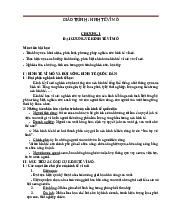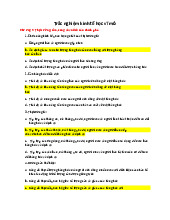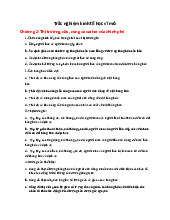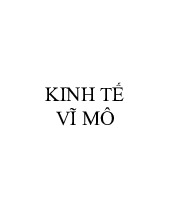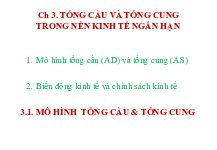






Preview text:
CHAPTER 1.
1.What happens to the economy during a recession?
Aggregate output declines for two consecutive quarters or more
Unemployment rates drop significantly
The government lowers taxes and increases spending Inflation rises sharply Correct 1/1 Points
2.What is the primary function of the labor market?
To allow firms to trade stocks and bonds
To match workers with jobs and determine wages
To regulate government tax policies
To facilitate the exchange of goods and services
3.What does the circular flow diagram illustrate?
The movement of money among economic groups in an economy
The movement of money, goods, and services among households and firms in an economy
The role of government in setting fiscal policy
The relationship between inflation and unemployment Correct 1/1 Points
4.What does the business cycle represent?
The way businesses grow and expand over time
The relationship between inflation and unemployment
The fluctuation of economic activity over time, including expansions and recessions The process of
businesses making decisions about production Correct 1/1 Points
5.What is the difference between microeconomics and macroeconomics?
Microeconomics examines inflation, while macroeconomics focuses on pricing Microeconomics
focuses on government policies, while macroeconomics focuses on individuals
Microeconomics studies individual markets, while macroeconomics studies the economy as a whole
Microeconomics studies international trade, while macroeconomics studies local businesses Correct 1/1 Points
6.What is the purpose of monetary policy?
To control the level of taxes and government spending
To regulate labor wages and prices of goods
To influence the money supply and interest rates to stabilize the economy
To eliminate all forms of unemployment Correct 1/1 Points
7.What does fiscal policy primarily involve? Laws controlling monopolies
Policies regulating foreign exchange rates
Government decisions on taxation and spending
Government decisions on interest rates and money supply Correct 1/1 Points
8.What are the three major market arenas in macroeconomics?
Private sector, public sector, and international sector
Goods-and-services market, labor market, and financial market
Consumer market, labor market, and stock market
Domestic market, global market, and underground market Correct 1/1 Points
9.What is the term for a period of prolonged and deep recession? Recovery Expansion Depression Inflation Correct 1/1 Points
10.Which of the following is NOT a component of the macroeconomy? Firms Natural Resources Government Households Correct 1/1 Points
11.Which of the following is NOT a type of financial market? Labor market Capital market Money market Stock market Correct 1/1 Points
12.What is the primary focus of macroeconomics?
The study of the economy as a whole, including policies and aggregate trends
The production decisions of a single company
The behavior of individual households and firms
The interaction of buyers and sellers in a market Incorrect 0/1 Points
13.What is an example of an exogenous variable in demand model?
The price of a product in a competitive market
The price and availability of raw materials, determined outside the model The income level of buyers
The number of firms in a particular industry Correct 1/1 Points
14.Which of the following best defines economics?
The study of how society manages its scarce resources
The study of how to eliminate scarcity
The study of how businesses maximize profits
The study of wealth accumulation Incorrect 0/1 Points
15.What role does the government play in the macroeconomy?
It controls all businesses and production directly
It does not interact with markets at all
It only provides laws and does not affect economic policies
It influences the economy through fiscal and monetary policies Correct 1/1 Points
16.Which of the following is NOT a major concern of macroeconomics? Output growth Unemployment
Market structure of a specific industry Inflation Correct 1/1 Points
17.In a market economy, who makes decisions about what to produce? The government alone International organizations The central bank
Households and firms through supply and demand Incorrect 0/1 Points
18.What is the role of households in the circular flow model?
Households supply labor to firms, government and the rest of the world
Households primarily regulate foreign trade
Households consume goods and services
Households receive income from selling factors of production and spend it on goods and services Correct 1/1 Points
19.What is the term used to describe a period of very rapid increases in the overall price level? Disinflation Deflation Stagflation Hyperinflation Option 5 Correct 1/1 Points
20.What is the definition of scarcity in economics?
The study of how firms make pricing decisions
The unlimited availability of resources
The availability of money in an economy
The limited resources that cannot fulfill all human wants and needs CHAPTER 3.
1.According to Keynes, the most important determinant of consumption is:
Expectations about future inflation Government spending Disposable income Interest rates Correct 1/1 Points
2.If the marginal propensity to consume (MPC) is 0.6, what is the marginal propensity to save (MPS)? 0.6 2.5 5/3 0.4 Correct 1/1 Points
3.Autonomous consumption refers to consumption that: Depends on interest rates Does not depend on income Depends only on income Depends on investment Correct 1/1 Points
4.If income increases, Keynesian theory suggests that total consumption will: Decrease
Increase, but by less than the increase in income
Increase by the same amount as income Remain constant Correct 1/1 Points
5.The average propensity to consume (APC) is defined as: C+S Y/C C/Y ΔC/ΔY Correct 1/1 Points
6.If consumption exceeds income in a given period, it means that:
People are borrowing or using past savings The MPC is greater than 1 There is a budget surplus Investment is decreasing Correct 1/1 Points
7.In a simple economy, planned investment refers to:
The actual level of investment that occurs in an economy
Government expenditure on public projects
The total spending by firms on capital goods and inventories
The level of investment firms intends to undertake Correct 1/1 Points
8.Actual investment differs from planned investment when: Government spending decreases
There is no change in inventories
There are unexpected changes in inventories
Businesses accurately forecast future demand Correct 1/1 Points
9.In the Keynesian model, planned investment is determined mainly by:
Interest rates and business expectations The money supply The current account balance Government spending Correct 1/1 Points
10.If businesses sell more than they expected, their actual investment will be: Equal to planned investment Unaffected
More than planned investment Less than planned investment CHAPTER 8.
1.The short-run aggregate supply curve is _________, while the long-run aggregate supply curve is _____________.
Upward sloping; downward sloping Vertical; upward sloping Upward sloping; horizontal Upward sloping; vertical Downward sloping; vertical
2.If the central bank decreases the supply of money, then the aggregate demand curve will:
become flatter. be unchanged. become steeper. shift to the left. shift to the right.
3.A positive demand shock will cause, in the short run, I. economic growth II. inflation III. increased employment II and III only III only I only I, II and III II only
4.Oscar recently quit his job at the city sanitation office and is applying for openings in the park
departments. Oscar is currently Out of the labor force Seasonally unemployed Structurally unemployed Frictionally unemployed Cyclically unemployed
5.If the government increases government spending, then the aggregate demand curve will: shift to the left. become steeper. shift to the right. become flatter.
6.When workers lose their jobs because there is no longer a demand for their particular skills, it is
called ____________ unemployment. Cyclical Structural Seasonal Operational Frictional
7.Which of the following could cause inflation in the short run? A decrease in the wage rate
An increase in the amount of imports
A decrease in the amount of exports
A decrease in consumer incomes
An increase in the price of an energy source such as natural gas
8.Suppose that energy prices increase across the economy. The short-run aggregate
supply (SRAS) curve will: shift to the right. be unchanged. move to the veritcal part. shift to the left.
9.Because of the relationship between prices and the real money supply, the aggregate demand curve is: upward-sloping. vertical. horizontal. downward- sloping.
10.All else equal, if there is an increase in the nominal wage rate, the price level will _________ and
the amount of aggregate output will ___________in the short run. Increase; decrease Decrease; decrease Increase; increase Increase; remain unchanged Remain unchanged; increase
11.The natural rate of unemployment is equal to
Frictional unemployment plus structural unemployment plus cyclical unemployment Structural unemployment Frictional unemployment Zero unemployment
Frictional unemployment plus structural unemployment
12.A nation has a working-age population of 95 million, with 81 million working and 5 million not
working and not looking for work. The unemployment rate is 5.2% 10% 88% 93% 14.7%
13.Grover was released from his sales job at the auto dealership when the economy slipped into a
recession. Grover is classified as (C) Out of the labor force (A) Structurally unemployed (E) Cyclically unemployed (D) Frictionally unemployed (B) Seasonally unemployed
14.Which of the following statements accurately describes why aggregate demand curves slope downward? I.
When income levels rise, all else equal, consumers increase spending at all price levels. II.
When interest rates fall, all else equal, firms increase investment spending at any price level. III.
When the price level falls, all else equal, the value of saved assets rises and consumers increase spending. I and II only II only II and III only I only III only
15.If the government raises taxes and the central bank maintains a policy of keeping the interest rate
constant, then the combined effect of these two policies would cause income to: fall. stay the same.
It cannot be determined from the information given. rise.
